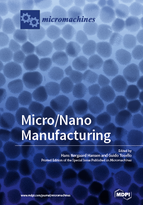Micro/Nano Manufacturing
A special issue of Micromachines (ISSN 2072-666X). This special issue belongs to the section "D:Materials and Processing".
Deadline for manuscript submissions: closed (31 May 2017) | Viewed by 73503
Special Issue Editors
Interests: metrology; micro manufacturing; additive manufacturing
Special Issues, Collections and Topics in MDPI journals
Interests: micro- and nanoscale polymer manufacturing; micro- and nanometrology; additive manufacturing; surface replication
Special Issues, Collections and Topics in MDPI journals
Special Issue Information
Dear Colleagues,
Micro- and nano-scale manufacturing has been the subject of more and more research and industrial focus over the past 10 years. Traditional lithography-based technology forms the basis of micro-electro-mechanical systems (MEMS) manufacturing, but also precision manufacturing technologies have been developed to cover micro-scale dimensions and accuracies. Furthermore, these fundamentally different technology platforms are currently combined in order to exploit strengths of both platforms. One example is the use of lithography-based technologies to establish nanostructures that are subsequently transferred to 3D geometries via injection molding. Manufacturing processes at the micro-scale are the key-enabling technologies to bridge the gap between the nano- and the macro-worlds to increase the accuracy of micro/nano-precision production technologies, and to integrate different dimensional scales in mass-manufacturing processes. Accordingly, this Special Issue seeks to showcase research papers, short communications, and review articles that focus on novel methodological developments in micro- and nano-scale manufacturing, i.e., on novel process chains including process optimization, quality assurance approaches and metrology.
We look forward to receiving your submissions!
Prof. Dr. Hans Nørgaard Hansen
Prof. Dr. Guido Tosello
Guest Editors
Manuscript Submission Information
Manuscripts should be submitted online at www.mdpi.com by registering and logging in to this website. Once you are registered, click here to go to the submission form. Manuscripts can be submitted until the deadline. All submissions that pass pre-check are peer-reviewed. Accepted papers will be published continuously in the journal (as soon as accepted) and will be listed together on the special issue website. Research articles, review articles as well as short communications are invited. For planned papers, a title and short abstract (about 100 words) can be sent to the Editorial Office for announcement on this website.
Submitted manuscripts should not have been published previously, nor be under consideration for publication elsewhere (except conference proceedings papers). All manuscripts are thoroughly refereed through a single-blind peer-review process. A guide for authors and other relevant information for submission of manuscripts is available on the Instructions for Authors page. Micromachines is an international peer-reviewed open access monthly journal published by MDPI.
Please visit the Instructions for Authors page before submitting a manuscript. The Article Processing Charge (APC) for publication in this open access journal is 2600 CHF (Swiss Francs). Submitted papers should be well formatted and use good English. Authors may use MDPI's English editing service prior to publication or during author revisions.
Keywords
- Micro- and nano-manufacturing
- Process chains
- Micro- and nano-metrology
- Micro- and nano-scale replication








